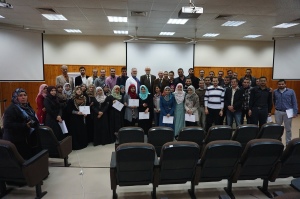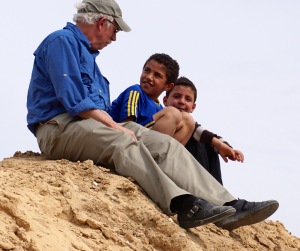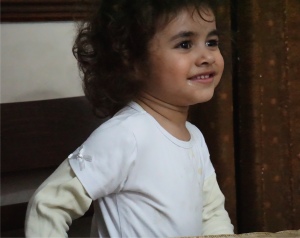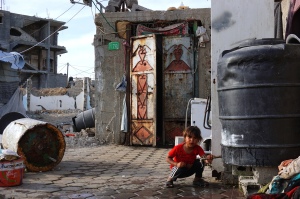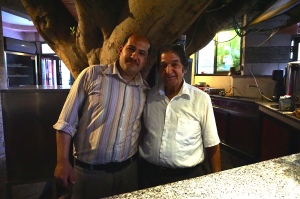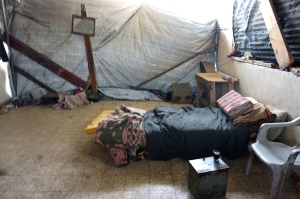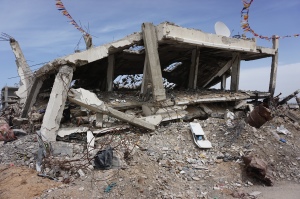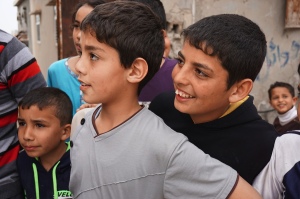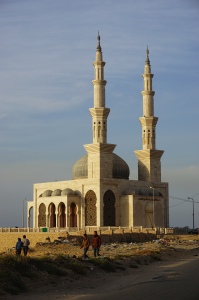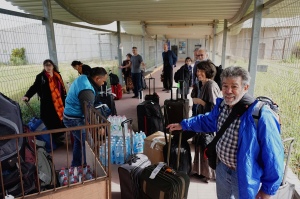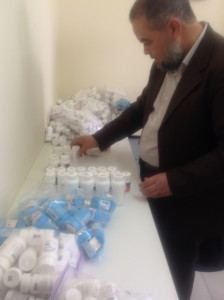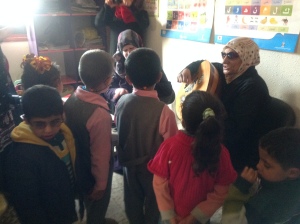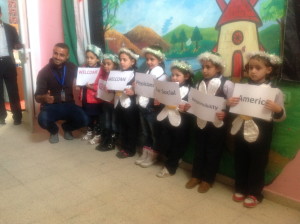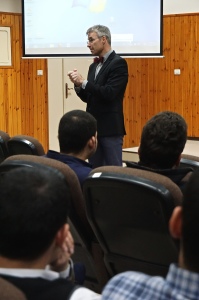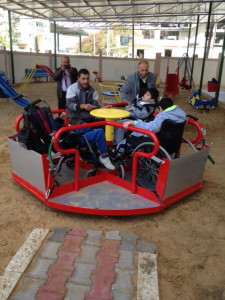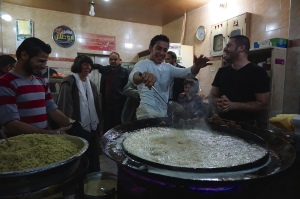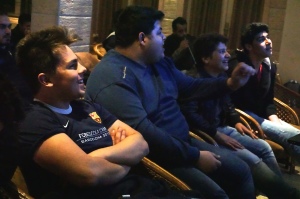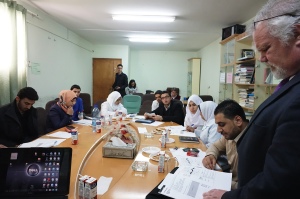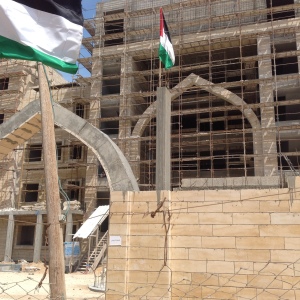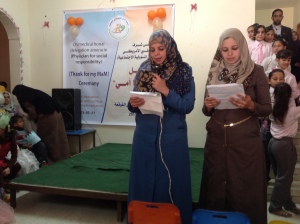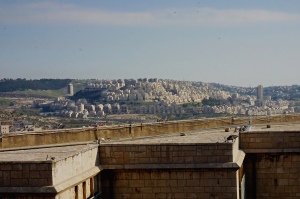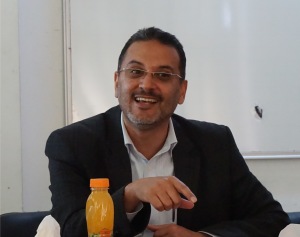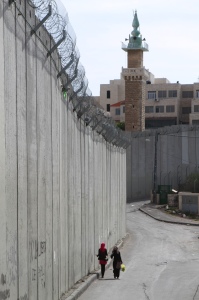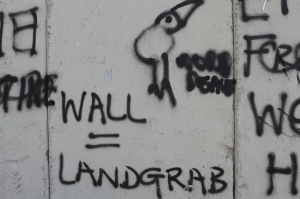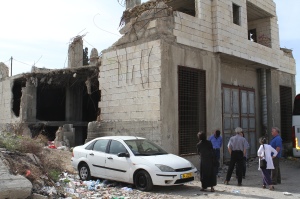Gaza has plenty of physicians and nurses. It has its own medical and nursing schools. But what is limiting for Gaza’s health care professionals is post-graduate and continuing medical education.
Due to the siege and closure as a direct result of the Israeli occupation, Gaza is cut off from the outside world; it is very difficult for Gaza’s health professionals to travel outside of Gaza for medical specialty training, or for continuing medical education. It is also difficult for outside educators to travel into Gaza. These interactions inside and outside the strip do occur, but the logistics are very complicated given that Israel controls who may travel and who may not in and out of the Strip.
ACLS is a course developed by the American Heart Association, which teaches current evidence-based clinical practice for evaluating and treating cardiopulmonary arrest as well as pre-arrest conditions. It is designed to maximize the possibility for survival of patients who suffer from these conditions.
In its full form, ACLS is a 15-hour course offered over 2 days. Students are provided with a student manual a month before the course, and it is expected that they thoroughly study the manual before the course begins. In order to be certified by the American Heart Association, students must complete the entire course, demonstrate competency in managing cardiac arrest, and pass a written exam.
Since April 2013, Dr. Bob Haynes and I have brought elements of ACLS to Gaza. It has been an evolving enterprise that necessitates creative improvisation:
1) First, planning a course requires getting into Gaza. This requires approval of our admission by Israeli authorities. Though we have typically applied for travel to Gaza through our delegation months in advance, we often have not been granted approval to enter Gaza until weeks prior to our scheduled arrival.
2) Next, we coordinate with our contacts in Gaza. When, where and for how long will each course occur? This also includes the question of how many different venues we will be able to offer courses in during the week that we are here. We typically do not know this information until after our arrival, nor do we know how many students we will have until we arrive at the venue to teach the course. We have had classes as small as 15 students, and also huge classes in a large auditorium with over a hundred students. These medical and nursing students have varying levels of expertise.
3) Because of these factors, it has been so far impossible to provide student manuals to our students a month in advance.
4) The amount of time allotted for each class has varied from 3 hours to about 10 hours.
5) There are language and cultural logistical hurdles to negotiate. We do not speak Arabic, but fortunately most of our students understand English. In past venues, we have taught in English with the assistance of English-Arabic interpreters.
6) We figure in coffee breaks, meal breaks, and breaks for prayer. These necessities and their timing are often not clear before we start the course.
7) The quality of Audio Visual Aids, IT systems, teaching mannequins, ventilatory equipment and defibrillators varies at each venue.
Our teaching experience has been rewarding. Doctors and nurses in Gaza have appreciated our classes. We can see it in their eyes and feel it by the endless gestures of gratitude and hospitality that they extend to us. Although it is only a small gesture, we are also showing that there are those of us in the outside world that deeply care about Gaza and its people at a time when folks from here often feel that the world has abandoned them.
(Washington Physicians for Social Responsibility has traveled to Gaza since 1993. Since 2009, following the Cast Lead invasion by Israel, WPSR has sponsored nine medical delegations to serve the people of Gaza.)
Parents tell us they have prepared their children for the steps to be taken in evacuating their home if the ever-present possibility of another attack by Israel becomes a reality. I hear this and know that no child should have to grow up with such a “game plan.”
Conversations with medical professionals here center on survival, treatment, plans for the future, needs and strategies. We hear of the critical difference between adaptation and coping.
Adapting to life under siege carries the inference that the present situation will become normal. Coping with life under siege does not allow the possibility that the present reality is permanent. Coping requires the daily evaluation of the situation and decisions about how life is to be conducted. Coping allows the continuance of hope. Adaptation is passive and admits to the power of the oppressor. Coping is active. There is personal power in coping.Further discussion centers on “needs” versus “rights”. Clearly, we are told that basic human rights have been evacuated in Gaza. Of course, food and clean water are needed, but we hear again and again that partially filling these needs does not replace the essential right of people to provide for
themselves – the right to freedom, the right to security, the right to dignity.“If our basic rights were respected, we would be able to fulfill our needs. We are an industrious people. We are an imprisoned people.” I am reminded of the role my taxes play in this imprisonment.
I copy below the articles of rights as articulated by the United Nations doctrine of human rights. This may seem long – unless you live in Gaza.
Article 1.
All human beings are born free and equal in dignity and rights. They are endowed with reason and conscience and should act towards one another in a spirit of brotherhood.
Article 2.
Everyone is entitled to all the rights and freedoms set forth in this Declaration, without distinction of any kind, such as race, colour, sex, language, religion, political or other opinion, national or social origin, property, birth or other status. Furthermore, no distinction shall be made on the basis of the political, jurisdictional or international status of the country or territory to which a person belongs, whether it be independent, trust, non-self-governing or under any other limitation of sovereignty.
Article 3.
Everyone has the right to life, liberty and security of person.
Article 4.
No one shall be held in slavery or servitude; slavery and the slave trade shall be prohibited in all their forms.
Article 5.
No one shall be subjected to torture or to cruel, inhuman or degrading treatment or punishment.
Article 6.
Everyone has the right to recognition everywhere as a person before the law.
Article 7.
All are equal before the law and are entitled without any discrimination to equal protection of the law. All are entitled to equal protection against any discrimination in violation of this Declaration and against any incitement to such discrimination.
Article 8.
Everyone has the right to an effective remedy by the competent national tribunals for acts violating the fundamental rights granted him by the constitution or by law.
Article 9.
No one shall be subjected to arbitrary arrest, detention or exile.
Article 10.
Everyone is entitled in full equality to a fair and public hearing by an independent and impartial tribunal, in the determination of his rights and obligations and of any criminal charge against him.
Article 11.
(1) Everyone charged with a penal offence has the right to be presumed innocent until proved guilty according to law in a public trial at which he has had all the guarantees necessary for his defence.
(2) No one shall be held guilty of any penal offence on account of any act or omission which did not constitute a penal offence, under national or international law, at the time when it was committed. Nor shall a heavier penalty be imposed than the one that was applicable at the time the penal offence was committed.
Article 12.
No one shall be subjected to arbitrary interference with his privacy, family, home or correspondence, nor to attacks upon his honour and reputation. Everyone has the right to the protection of the law against such interference or attacks.
Article 13.
(1) Everyone has the right to freedom of movement and residence within the borders of each state.
(2) Everyone has the right to leave any country, including his own, and to return to his country.
Article 14.
(1) Everyone has the right to seek and to enjoy in other countries asylum from persecution.
(2) This right may not be invoked in the case of prosecutions genuinely arising from non-political crimes or from acts contrary to the purposes and principles of the United Nations.
Article 15.
(1) Everyone has the right to a nationality.
(2) No one shall be arbitrarily deprived of his nationality nor denied the right to change his nationality.
Article 16.
(1) Men and women of full age, without any limitation due to race, nationality or religion, have the right to marry and to found a family. They are entitled to equal rights as to marriage, during marriage and at its dissolution.
(2) Marriage shall be entered into only with the free and full consent of the intending spouses.
(3) The family is the natural and fundamental group unit of society and is entitled to protection by society and the State.
Article 17.
(1) Everyone has the right to own property alone as well as in association with others.
(2) No one shall be arbitrarily deprived of his property.
Article 18.
Everyone has the right to freedom of thought, conscience and religion; this right includes freedom to change his religion or belief, and freedom, either alone or in community with others and in public or private, to manifest his religion or belief in teaching, practice, worship and observance.
Article 19.
Everyone has the right to freedom of opinion and expression; this right includes freedom to hold opinions without interference and to seek, receive and impart information and ideas through any media and regardless of frontiers.
Article 20.
(1) Everyone has the right to freedom of peaceful assembly and association.
(2) No one may be compelled to belong to an association.
Article 21.
(1) Everyone has the right to take part in the government of his country, directly or through freely chosen representatives.
(2) Everyone has the right of equal access to public service in his country.
(3) The will of the people shall be the basis of the authority of government; this will shall be expressed in periodic and genuine elections which shall be by universal and equal suffrage and shall be held by secret vote or by equivalent free voting procedures.
Article 22.
Everyone, as a member of society, has the right to social security and is entitled to realization, through national effort and international co-operation and in accordance with the organization and resources of each State, of the economic, social and cultural rights indispensable for his dignity and the free development of his personality.
Article 23.
(1) Everyone has the right to work, to free choice of employment, to just and favourable conditions of work and to protection against unemployment.
(2) Everyone, without any discrimination, has the right to equal pay for equal work.
(3) Everyone who works has the right to just and favourable remuneration ensuring for himself and his family an existence worthy of human dignity, and supplemented, if necessary, by other means of social protection.
(4) Everyone has the right to form and to join trade unions for the protection of his interests.
Article 24.
Everyone has the right to rest and leisure, including reasonable limitation of working hours and periodic holidays with pay.
Article 25.
(1) Everyone has the right to a standard of living adequate for the health and well-being of himself and of his family, including food, clothing, housing and medical care and necessary social services, and the right to security in the event of unemployment, sickness, disability, widowhood, old age or other lack of livelihood in circumstances beyond his control.
(2) Motherhood and childhood are entitled to special care and assistance. All children, whether born in or out of wedlock, shall enjoy the same social protection.
Article 26.
(1) Everyone has the right to education. Education shall be free, at least in the elementary and fundamental stages. Elementary education shall be compulsory. Technical and professional education shall be made generally available and higher education shall be equally accessible to all on the basis of merit.
(2) Education shall be directed to the full development of the human personality and to the strengthening of respect for human rights and fundamental freedoms. It shall promote understanding, tolerance and friendship among all nations, racial or religious groups, and shall further the activities of the United Nations for the maintenance of peace.
(3) Parents have a prior right to choose the kind of education that shall be given to their children.
Article 27.
(1) Everyone has the right freely to participate in the cultural life of the community, to enjoy the arts and to share in scientific advancement and its benefits.
(2) Everyone has the right to the protection of the moral and material interests resulting from any scientific, literary or artistic production of which he is the author.
Article 28.
Everyone is entitled to a social and international order in which the rights and freedoms set forth in this Declaration can be fully realized.
Article 29.
(1) Everyone has duties to the community in which alone the free and full development of his personality is possible.
(2) In the exercise of his rights and freedoms, everyone shall be subject only to such limitations as are determined by law solely for the purpose of securing due recognition and respect for the rights and freedoms of others and of meeting the just requirements of morality, public order and the general welfare in a democratic society.
(3) These rights and freedoms may in no case be exercised contrary to the purposes and principles of the United Nations.
Article 30.
Nothing in this Declaration may be interpreted as implying for any State, group or person any right to engage in any activity or to perform any act aimed at the destruction of any of the rights and freedoms set forth herein.
(Washington Physicians for Social Responsibility has traveled to Gaza since 1993. Since 2009, following the Cast Lead invasion by Israel, WPSR has sponsored nine medical delegations to serve the people of Gaza.)
We were joined for our bus tour by many of the young women from the Gaza Community Mental Health Programme who have helped with our time in Gaza. When they learned I was about to sing “Happy Birthday” to Joan, they crowded around my phone and sent her a joyful greeting! “Happy Birthday” is one song that knows no borders – the tune is the same in every language and we sang first in English, then in Arabic. Happy Birthday, Joan!
Hamada Al Bayari from The United Nations Office for the Coordination of Humanitarian Affairs (UNOCHA) spent the morning with us, telling us of his work and narrating the challenges faced by people living in the destroyed areas of Northern Gaza.We stood on the bare earth in places near the border with Israel where the local economy was destroyed when Israeli bulldozers uprooted olive and citrus trees – to improve visual “security”.
The heartbreaking scenes in every village along the northern border revealed that almost no repairs or rebuilding has occurred since our visit here in November 2014. Remains of thousands of bombed
homes lie in heaps along street after street.Where the potential for shelter exists, families continue to live in these ruins. For most of these areas, access to electricity, water, and sewage service was also destroyed and through the cold and very wet winter, families have struggled to survive.
Tens of thousands of Gaza’s residents still shelter with other families, in UN schools, in scrap metal structures, temporary caravans or in the bombed out caverns of their previous residences. Political barriers continue to prevent reconstruction money (and money from taxes) from reaching Gaza – money that could provide building materials and jobs for vastly unemployed Gazans.
Before Egypt destroyed hundreds of tunnels between Rafah and Egypt, some construction materials came to Gaza through the southern border. Now, all materials must come through the singular “goods” crossing between Israel and Gaza at Kerem Shalom and precious few materials are arriving.
So, tens of thousands of Gazans remain homeless. Tens of thousands of Gazans remain jobless. Tens of thousands of Gazans who have jobs as doctors, nurses, social workers, etc. continue to work with no pay.
Our afternoon tour of Gaza took us south to the Rafah border. We visited the tunnel area where destruction was evident and learned that a few tunnels are being rehabilitated. For the first time in many visits, we were escorted deep into one of the tunnels, a small space, wired and lit through the efforts of local men.Large quantities of material could not move quickly through this space, but the possibility of any connection with the “outside” world is compelling to a fully imprisoned Gaza.
Through the magic of cell phone communication, our hosts were able to locate one small boy in Rafah City. A World Vision patron in Seattle had asked that we take gifts to this boy and we briefly visited him and his grandparents in the compound of his home.
Along the Western border with Israel, strips of homes and tunnels were destroyed by Israeli bombs and tanks in the 2014 assault. We visited one of these areas and found that, as in the North, virtually no reconstruction has occurred. Desperately poor people shelter in the bombed out remains of their homes. Cloth and cardboard walls provide little protection to small rooms that house many people.
We visited one family of eight living in a single room of perhaps 350 square feet, its walls damaged or destroyed. We realized again that this family is one of many thousands. The number is overwhelming – the powerlessness to provide the volume of help needed is sickening.
Where is the world community – why is this being allowed to continue? And with these questions, the background voice of the people repeats, “If we rebuild, how long will it be before Israel again destroys?”
(Washington Physicians for Social Responsibility has traveled to Gaza since 1993. Since 2009, following the Cast Lead invasion by Israel, WPSR has sponsored nine medical delegations to serve the people of Gaza.)
For about 25 years, I’ve facilitated a wonderful group for Moms who have experienced the death of one or more of their children. I’ve taught in the US, Canada, Israel, Palestine, and Iraq.
Today, I spent three hours with a group of medical professionals who are studying with the Gaza Community Mental Health Programme. They are steeped in the grief and bereavement of Gaza.
Believing that everything that happens is from Allah, these students were gracious in our discussion that sadness is still a part of what happens when a loved one dies or a community is demolished.
Some members of this group had experienced the death of a relative in last year’s assault on Gaza. Everyone acknowledged the sense that another attack is possible and that all of Gaza lives with this reality.
Discussing grief and bereavement in a frequent war zone means
re-examining context. Gaza has been under a severe siege by Israel since 2007. Three major assaults by bombing have resulted in loss of life and the widespread destruction of homes and livelihood.To study grief here requires a global view. Here there is grief over the loss of freedom, the lack of security, limited access to economic possibility, compromised education, no clean water – the list is long and touches nearly all aspects of life. Against this ongoing and unrelieved list of sorrows exists the ever-present reality of armed drones and patrolling gunships.
Today, we talked about no “post” to traumatic stress injury. We spoke of Continuous Traumatic Stress Injury (CTSI) instead of Post Traumatic Stress Disorder (PTSD) and how CTSI is, in itself, a focus of grief.
Continuous injury implies that healing is an ongoing and repetitive (and incomplete) process. And we acknowledged the reality that “broken heart syndrome” may be present here – the reality that the most faithful person may have overwhelming sorrow.
The cycle of grief, moving from shock to reinvestment (through denial, magical thinking, reality, pain and reorganization) still occurs. The shock of grief may mimic hemorrhagic shock in its affect on body function – including a clouding of thought and mental processing.
We talked about the difference between a slow death from illness and the death associated with war. It was a good discussion.
As we reviewed the organization of a decision-making process that can help patients and families approach a terminal illness with greater awareness of choice, we celebrated that families always participate here – care in Gaza is family-centered, with extended family members always accompanying a patient seeking care.
The First Palestinian Turkish Conference of Surgery, the conference that occasioned this journey to Gaza, began this morning. Grant O’Keefe gave two lectures today and will speak again tomorrow.
Grant is a great teacher and some members of our group were able to attend the conference and hear Grant’s messages about trauma care – essential messages in this traumatized land.
The July-August 2014 assault killed about 2200 Gazans, wounded over 11,000 people, destroyed over 14,000 homes, displaced initially about half a million people and left about 100,000 people homeless. Palestinians in Gaza are now limited to about 6 hours of electricity per day with rotating blackouts.
When I came to Gaza in November 2014, very little had been accomplished in terms of reconstruction. The international community had pledged billions in reconstruction aid, but very little had made it into Gaza. This delay has reportedly been primarily due to onerous restrictions by Israel, while maintaining a comprehensive eight-year siege on Gaza. I am told, “The Israelis control every aspect of our lives.”
Prior to the siege and the election of the Hamas government, Israel internally occupied Gaza and the population was subjected to a severely restricted life. The population of Gaza is growing and now numbers about 1.8 million.
Our Gaza colleagues tell us that Gaza does not need more aid as much as Gaza needs freedom.
Bokra, Bokra fil Mish Mish
This is a famous Palestinian saying, which loosely translates into “tomorrow, tomorrow never comes”. In spite of the reconstruction conference in Cairo at the end of last summer’s conflict, attended by US Secretary of State John Kerry and others, very little war damage has been repaired. It is deja vu all over again.
Previous wars brought promises of more freedom and reconstruction but these promises brought little in relief to the people of Gaza. Palestinian leaders are never invited to participate in the reconstruction conferences.
A similar conference attended by the previous US Secretary of State Hillary Clinton at the Egyptian resort town of Sharm El Sheikh in 2009 at the end of the Israeli assault called Cast Lead led to few tangible results. Locals here do not believe that this time will be any different. “We are all alone without the support of the world.”
Before last summer, 69 percent of the people in Gaza were dependent on humanitarian assistance. Now that figure hovers at around 80 percent.
People are still living in the streets and in ramshackle shelters scattered throughout the Strip. With no permanent housing for many people, several young children died of exposure-related hypothermia during the winter of 2014-2015.
By November of last year, 60,000 of the original 100,000 homeless remained homeless, and many remain homeless today. Those no longer considered homeless include families who have been absorbed by extended families and are living in overcrowded conditions.
Some UN schools are still being used to house homeless families – placing additional stress on those schools, which have now moved from double to triple shifting of classes in order to meet classroom needs.
According to Dr. Yasser Jamai, director of Gaza Community Mental Health Programme, there has been no improvement in the political, environmental or reconstruction situation. Now with the re-election of Benjamin “Bibi” Netanyahu in Israel last week, many believe that it is only a matter of time before Gaza is under attack again.
In spite of all this, Dr. Yasser, who lost many close family members last summer says, “If you survive the trauma, it makes you stronger, it gives you more power to cope with the hopeless situation.” He adds that close family bonds and the power of religion keeps this society together.
I am told by many friends in Gaza that this visit and our efforts to empower medical services give them some hope. I hope this is so.
During this next week, we will compare the present situation with what we witnessed in November. We will see what has changed, what remains the same and where help from the outside world might make a difference.
(Washington Physicians for Social Responsibility has traveled to Gaza since 1993. Since 2009, following the Cast Lead invasion by Israel, WPSR has sponsored nine medical delegations to serve the people of Gaza.)
Medical care in Gaza is good but the siege imprisons patients and practitioners alike. Continuing education is hampered by the lack of freedom of movement across borders to other countries and the lack of access to adequate equipment and supplies causes patient care to suffer. Still, the medical personnel of Gaza provide conscientious and loving care.
For our visit, patients are referred each day for consultation at Marna House. A child needing care not available in Gaza cannot afford the care that transport to another country would cost – even if she could gain permission to leave. The stories wrench the heart and inflame the conscience. Why is this happening? The collective punishment of 1.8+ million people is impossible to understand.
This morning, the medicines purchased with funds donated by
many in Washington were delivered to the Gaza Community Mental Health Programme. “Our patients need these medicines and we run out of them”, we are told.Delayed permission to enter Gaza meant that the order for medicines had to be delayed and the supply of requested medicines could not be fully filled. Still, the partially replenished stock was happily received!
While teaching and consulting and operating continued through the day, lessons about the work of Gaza’s NGOs were offered!
Several of us visited a center for the care of partially sighted and blind children. We met children
who held tenderly to one another as they sang – finding their way around the song circle by touch.Children in the Center learn to type in Braille and their Braille printer allows them to create books for use by all of the children. Dr. Al Kashif, formerly of the Ministry of Health and a long-time friend, toured us through this center that he helped to create!
Another visit to Mira Kindergarten rewarded us with dancing, singing and joyful clapping with the children and staff. A sign thanking WPSR for helping the kindergarten adorned the wall.
We toured the building and met children one-by-one – and we learned that many of them lost siblings and one or both parents in last summer’s war on Gaza. Loss in so many families seems present everywhere.
We visited the Al Amal orphanage. The facility has expanded to serve 150 children (age 5 – 18) on site and another 150 children in the community. With 20,000 orphans in Gaza (most related to wars), the work of the orphanage is always needed.
In the coming year, the staff hopes to expand services to include children from birth to 5 years – recognizing the agonizing need for care that this population is experiencing.
With the electricity situation in Gaza always threatened (electricity is sometimes available only in three-hour segments), the orphanage staff is hoping to install solar panels on their buildings. They estimate to cost of this expressions at $100,000. Donors are needed!
While some of our group traveled north to the ruined towns of Beit Hanoun and Shujayia to watch young men perform Parkour on the rubble that remains of these two towns, others were able to visit with friends made in previous visits.
Firsthand stories of life in a city under constant threat of attack are sobering. Knowing that any small modicum of safety can disappear instantly is something most of us can barely understand. Still, the humor and steadfast decision to remain in Gaza – to remain “home” fills many interactions.
The people of Gaza comprise an inspiring and amazing community!
(Washington Physicians for Social Responsibility has traveled to Gaza since 1993. Since 2009, following the Cast Lead invasion by Israel, WPSR has sponsored nine medical delegations to serve the people of Gaza.)
Bob Haynes and Bill Dienst initiated a full course in Advanced Cardiac Life Support. They will spend the next two days with this group, providing a full ACLS course. The morning was great fun for all of us!
Several members of our group visited the Palestine Future Institution – Center for the care of children with cerebral palsy. This Center serves 150 children with varying levels of ability in an amazing, loving atmosphere.
The children are integrated as much as possible into area schools for part of their education – this is a carefully monitored process. The director, who told me during our last visit that he doesn’t love his job, he adores it, gave us a tour of the facility and demonstrated the new playground equipment he recently acquired – equipment that
accommodates children in wheelchairs.The Center’s library is being expanded and we were again thankful to donors who gave us contributions for this important place.
We were then invited us to participate in a Mother’s Day celebration. In a large hall full of children, mothers and staff, we danced and clapped and cried and were grateful to be a part of this day.
Near the end of the hour, the teacher leading the activities spoke of Koranic teachings about mothers and then told of the tragedy that last summer’s war on Gaza created.
Mothers and children were killed. In the assembly today, one young girl stood to be acknowledged and was held in the arms of many who have supported her in the months since her Mother died in an Israeli bombing.
The teacher told of emotional and material care provided to this girl by the staff of the Center. I have not experienced an atmosphere of greater love.
Our delegation continues to provide direct care. Chuck Cowan has a full schedule working with professionals and parents of children who have autism – exploring and teaching ways to improve family-centered care for these children.Grant O’Keefe operated through most of the day, returning in the evening to accompany our group to another falafel adventure.
The exuberance of the falafel vendors/craftsmen is fantastic to behold. They move with rapid precision to produce delicious food, but the joy they exude is their greatest product. They infect the crowd with laughter and delight – a lesson for all!
In Gaza, having survived three wars in six years, the intrepid spirit of the people shines forth.
(Washington Physicians for Social Responsibility has traveled to Gaza since 1993. Since 2009, following the Cast Lead invasion by Israel, WPSR has sponsored nine medical delegations to serve the people of Gaza.)
Today, our group dispersed to their various places of service. Chuck Cowan, pediatrician and specialist in autism, has a full calendar of classes and consultations. Grant O’Keefe, trauma surgeon is
working with local colleagues – consulting, teaching, operating. Bill Dienst and Bob Haynes are teaching Advanced Cardiac Life Support.More to follow on our jobs, but one highlight of the day was time with the staff and children of the Al Amal Cochlear Implant Center. Near the Mediterranean Sea, a new rehabilitation hospital is under construction – funded by Qatar.
The construction of this hospital was begun in 2012, but the disastrous attacks on Gaza by Israel last summer brought construction to a halt. Now there is hope that the beautiful building will be completed and provide the Cochlear Implant a new fourth floor
home.Miakoda Wolin-Collins, nurse, and Seema Jilani, pediatrician, and I were treated to a delayed Mother’s Day celebration (Gaza celebrated Mother’s Day yesterday on the first day of spring) in the existing Center. Children served by the Center danced and sang their gratitude to their mothers.
A wall hanging behind the children celebrated Washington Physicians for Social Responsibility and the support of donors to the work of the Center.
The population of children requiring hearing assistance in Gaza is significant and the dedication of the staff, working without pay, is inspiring.
Another inspiration in Gaza is the expanding work of Reem abu Jaber, Director of NAWA Center for Arts and Culture in central Gaza. (Please see NAWA on Facebook). I met with Reem this afternoon and learned of the rapid growth in the number of
children being served by NAWA.NAWA is dedicated to “The Power of Culture Confronting a Culture of Power.” Their vision is to “create a nurturing cultural hub for Palestinian families.” Psychosocial support, fine arts programs, family empowerment and professional development are featured in the work of Reem and her staff.
In the coming year, the library of NAWA will expand to the restored Al-Khader monastery in Deir el Balah. The rehabilitation of this site will provide a unique and beautiful home for study.
During the day, we were delighted to meet friends from previous visits to Gaza. The hospitality and grace of Gaza’s people endures in the presence of siege and ongoing collective punishment.
This evening, many members of our group met with Steve Sosebee, Director of the Palestinian Children’s Relief Fund, and a delegation of PCRF staff and physicians serving in Gaza. PCRF works in Gaza, the West Bank of Palestine, Lebanon and Jordan caring for children in need of medical services.
This organization has obtained free medical care for children in international sites and brings physicians from all over the world to care for children in the Middle East. Thousands of children have been served. To learn more about the work of PCRF, please see: www.pcrf.net
The staff of the Gaza Community Mental Health Programme facilitates our work and our learning – the dedication of GCMHP to Gaza continues to reflect the spirit of its founder, Dr. Eyad El Sarraj.
Thank you to GCMHP!
(Washington Physicians for Social Responsibility has traveled to Gaza since 1993. Since 2009, following the Cast Lead invasion by Israel, WPSR has sponsored nine medical delegations to serve the people of Gaza.)
Four of us arrived on Friday and spent the extra day in Bethlehem and/or Hebron. Wi’am, the Palestinian Conflict Resolution Center in Bethlehem, hosted us.
Zoughbi Zoughbi, the director of Wi’am, is the brilliant student of peace who organized the first WPSR visit to this area in 1993. Since then, the children of Zoughbi and his wife, Elaine, have become godchildren to Bob and me and we are always deeply grateful to return to Wi’am! We sat with Zoughbi as he briefed a Quaker delegation in his office and came away with this quote: “Blaming is toxic, dwelling on victimhood is suicidal, enhancing the guilt of others is paralyzing for all and collective responsibility is healing.”
Given the current situation in Palestine, we will reflect on these words again and again. We looked across the valley from Bethlehem to Jebel Abu D’neim, a previously beautifully wooded hillside, now covered by an Israeli settlement and renamed Har Homa.The visit to Hebron, guided by Usama, a Zoughbi family member and primary person on the Wi’am staff, provided a look at the increased development of settlements in Hebron and the resulting decreased freedom of movement for the area’s Palestinian families. The beautiful hills and valleys surrounding the road to Hebron provided views of Spring in the Holy Land.
This morning we traveled by bus to the Erez Checkpoint. Weeks of preparation and petition to Israel for permission enter Gaza resulted in a relatively smooth passage into the Palestinian area. We were able to
bring through, supported by gifts of many people in the US, essential medicines, medical supplies, education tools, and children’s books, toys and art supplies (in our many pieces of luggage!)The long trek through the caged walkway, overseen by the armed towers of the Israeli wall, has become a familiar experience – one, not without it’s ever-present feeling of imprisonment.
We were greeted by staff of our host, the Gaza Community Mental Health Programme (GCHP) and spent an enlightening time with Dr. Yasser Jamai, Director of GCMHP and Dr. Hussam El Nounou. The work they are doing
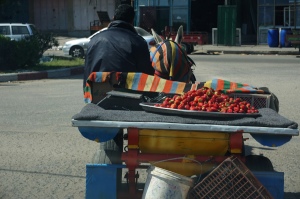
Beautiful strawberries, once a primary export of Gaza, now dispensed locally from carts because the full export is no longer allowed (photo by Bob Haynes)
In this land of war and the ever-present feeling that another attack is imminent, the courage and resilience of the GCMHP staff is amazing. The director of Public Relations and his staff have created a complex and comprehensive schedule for our work in the coming week.
We are again grateful to be here!
The Israeli Committee Against House Demolitions (ICAHD) was co-founded in 1997 by Dr. Jeff Halper.
The goal of this human rights organization is to resist and protest Israel’s policy of demolishing Palestinian homes. Jeff was nominated for the Nobel Peace Prize in 2006 and ICAHD received from Jewish Voice for Peace the Olive Branch award in 2007.
Today, our group spent four hours with an ICAHD guide traveling through East Jerusalem to learn more about land annexation, confiscation and housing destruction in the Occupied West Bank. Since 1967, Israel has destroyed nearly 30,000 homes and other structures constructed on Palestinian land. The reasons given for this destruction are many, but the result is always disruption of life for the Palestinians affected.
Israel often refuses Palestinians in East Jerusalem permission to build or expand their homes and the crowding in circumscribed Palestinian villages causes resentment and frustration. The Separation Wall built along or inside the 1967 Green Line has effectively usurped at least 10 percent of the West Bank Palestinian territory and much West Bank land has been confiscated by Israel.
Palestinians are left with tightly controlled land areas, separated from each other by the Wall and by Israeli-only bypass roads. The effect of this land confiscation, Wall-building, permit refusal and house demolition is a sense of imprisonment reminiscent of the open-air prison of Gaza.Last week in Gaza, we talked with a health care worker whose home was destroyed near Wadi Gaza. We visited the home site and met the man’s son and father. In the nearby area, land had been stripped of trees and every home had been leveled. The Israeli border was clearly visible in the near distance and we were told that military tunnels had been discovered and destroyed nearby.
Since Israel ended it’s internal occupation of Gaza in 2005, Gazans have been able to build on their land (outside the no-go zone), but the on-going siege (since 2007) that prevents the import of essential construction materials effectively thwarts adequate home building. Three wars that have destroyed thousands of existing homes mean that tens of thousands of Gazans are displaced and many are homeless.
The result of home demolitions throughout Palestine, land confiscation, siege, war, and the associated poverty is the real sense of growing containment or imprisonment for Palestinians. There is an air of tension in this region – violence is reported every day. We leave with the hope that justice will come and further war will be avoided.
